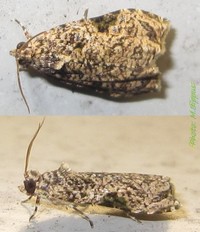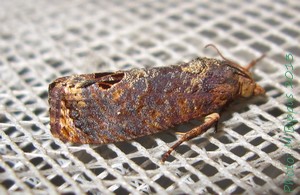
The Tortricidae are a family of moths, commonly known as tortrix moths or leafroller moths, in the order Lepidoptera. This large family has over 11,000 species described, and is the sole member of the superfamily Tortricoidea, although the genus Heliocosma is sometimes placed within this superfamily. Many of these are economically important pests. Olethreutidae is a junior synonym. The typical resting posture is with the wings folded back, producing a rather rounded profile.

Thaumatotibia (Cryptophlebia) leucotreta, commonly known as the false codling moth, orange moth, citrus codling moth or orange codling moth, is a moth in the family Tortricidae under the order of Lepidoptera. Larvae of the moth feed on a wide range of crops from cotton and macadamia nuts to Citrus species. The larvae have a less selective diet than the codling moth, which feeds primarily on temperate fruit crops.

Cryptophlebia is a genus of moths belonging to the subfamily Olethreutinae of the family Tortricidae.

Thaumatotibia is a genus of moths belonging to the family Tortricidae.

Cryptophlebia ombrodelta, the litchi fruit moth or macadamia nut borer, is a moth of the family Tortricidae. The species was first described by Oswald Bertram Lower in 1898. It is native to India, Sri Lanka, Nepal, Indonesia, China, Taiwan, Vietnam, Thailand, western Malaysia, New Guinea, the Philippines, Japan, Guam, the Caroline Islands, Australia and has been introduced to Hawaii.

Grapholitini is a tribe of tortrix moths.

Cryptophlebia illepida is a species of moth in the family Tortricidae that is endemic to the islands of Kauaʻi, Oʻahu, Molokaʻi, Maui, Lānaʻi and Hawaiʻi. Common names include koa seedworm, klu tortricid, koa seed moth, litchi borer, litchi moth, macadamia nut borer and macadamia nut moth. It was first described by Arthur Gardiner Butler in 1882.

Inocarpus fagifer, commonly known as the Tahitian chestnut or Polynesian chestnut, is a species of flowering plant in the subfamily Faboideae of the legume family, Fabaceae. The tree has a wide range in the tropics of the south-west Pacific and south-east Asian regions, and a history of traditional use by the peoples of Polynesia and Melanesia. It is the only edible and culturally important member of the genus Inocarpus.

Cryptophlebia repletana is a moth of the family Tortricidae. It is found in South-East Asia, including the Philippines, Sarawak, Taiwan, Fiji and Japan.

Homona mermerodes is a species of moth of the family Tortricidae first described by Edward Meyrick in 1910. It was described from the Solomon Islands, but is also found in Australia (Queensland), New Guinea and Seram. The habitat consists of bamboo, secondary forests and alluvial forests.
Alexey Nikolaievich Diakonoff, also transliterated as Alexej Nikolajewitsch Diakonoff, was a Russian–Dutch entomologist who specialised in Microlepidoptera.

Eccopsis praecedens is a moth of the family Tortricidae. It is found in western, central, eastern and southern Africa, including the islands of São Tomé, Cape Verde, Madagascar and Réunion.

Cryptophlebia peltastica is a moth of the family Tortricidae. It is found throughout Africa from Ghana to South Africa and Eritrea, including islands of the Indian Ocean and is also known from Asia, the Pacific region (Guam) and from the Bahamas.

Cryptophlebia semilunana is a moth of the family Tortricidae. It is found in Africa, where it is known from Kenya, Uganda, Tanzania, South Africa, Madagascar, Réunion and Mauritius.
Cryptophlebia rhynchias is a species of moth of the family Tortricidae first described by Edward Meyrick in 1905. It is found from Mauritius, India, Sri Lanka, the southern Mariana Islands, the New Hebrides, Fiji, Samoa, Sudest Island, the Society Islands, the Austral Islands and the Marquesas Islands to Australia. The habitat consists of bamboo and secondary forests.
Strepsicrates semicanella is a species of moth of the family Tortricidae first described by Francis Walker in 1866. It is found in south-east Asia and in New Caledonia, Australia and Japan. The habitat consists of alluvial forests.
Cryptophlebia heterospina is a species of moth of the family Tortricidae first described by Józef Razowski in. It is found on Seram Island in Indonesia. The habitat consists of bamboo and secondary forests.
Cryptophlebia amblyopa is a species of moth of the family Tortricidae. It is found in Micronesia and New Caledonia. The habitat consists of rainforests.
Cryptophlebia omphala is a species of moth of the family Tortricidae. It is found in New Caledonia. The habitat consists of rainforests and planted forests.










